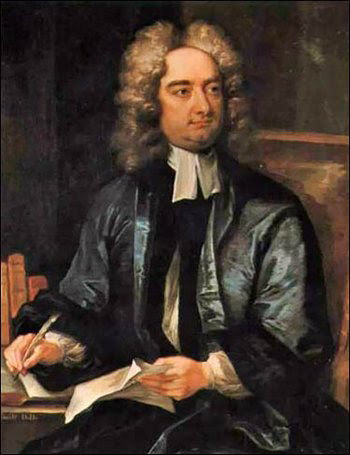Jonathan Swift

30 November: Born in Dublin, the son of Anglo-Irish parents. His father dies a few months before JS is born.
Begins his education at Kilkenny Grammar School, which was, at the time, the best in Ireland.
JS attends, and graduates from, Trinity College, Dublin, by "special favour".
William of Orange invades England, initiating the Glorious Revolution in England. With Dublin in political turmoil, Trinity College is closed, and JS goes to England.
JS becomes secretary in the household of Sir William Temple at Moor Park in Surrey. He reads extensively in Temple's library, and meets Esther Johnson, who will become his "Stella." He first begins to suffer from Meniere's Disease, a disturbance of the inner ear.
At the advice of his doctors, JS returns to Ireland.
JS, back with Temple in England, visits Oxford.
Temple enables JS to receive an M. A. degree from Oxford, and JS publishes his first poem.
JS leaves Temple's household and returns to Ireland to take holy orders.
JS ordained as a priest in the Church of Ireland, the Irish branch of the Anglican Church.
JS returns to Moor Park, and composes most of A Tale of a Tub, his first great work. In 1699 Temple dies, and JS travels to Ireland as chaplain and secretary to the Earl of Berkeley.
JS instituted Vicar of Laracor, and presented to the Prebend of Dunlavin in St. Patrick's Cathedral, Dublin.
JS awarded DD degree from Dublin University, and publishes his first political pamphlet, supporting the Whigs against the Tories.
Anonymous publication of A Tale of a Tub, The Battle of the Books, and The Mechanical Operation of the Spirit.
JS in London as emissary of Irish clergy seeking remission of the tax on Irish clerical incomes. His requests are rejected by the Whig government. He meets Esther Vanhomrigh, who will become his "Vanessa." During the next few years he is back and forth between Ireland and England, where he is involved in the highest political circles.
JS meets Addison and Steele, and publishes The Bickerstaff Papers and An Argument Against Abolishing Christianity.
Bickerstaff Predicitions for 1708
John Partridge, a cobbler, a well-known astrologer and a thorough rascal, had for years been putting out an annual almanac, the Merlinus Liberatus, containing predictions of forthcoming events. The wits had often attacked him but it was JS who delivered the most telling blows. Predictions for the Year 1708, purporting to be by one Isaac Bickerstaff, also an astrologer, appeared before the end of January, 1708. Here was foretold, among other things, the death of Partridge himself, to occur on March 29 about eleven at night. March 30 saw the appearance of The Elegy on Mr. Partridge -- a set of doggerel verses announcing the fulfillment of Bickerstaff's prophecy -- and a prose pamphlet, The Accomplishment of the First of Mr. Bickerstaff's Predictions, which announced that Partridge was indeed dead. Partridge's humiliation continued in the succeeding months, with those he met in the street amusing themselves at his expense and referring to his wife as "Widow Partridge". The hoax, gaining immense popularity, plagued Partridge until the real end of his life. Mourners, who believed him to be dead, often kept him awake at night crying outside his window. Accounts of an undertaker arriving at his house to arrange drapes for the mourning, an elegy being printed and even a gravestone being carved, all culminate in Partridge publishing a letter in hopes to have a last word on the matter and proclaim (and reclaim) himself as living.
JS returns to England. Publication of "A Description of a City Shower." JS falls out with Whigs, allies himself with the Tories, and becomes editor of the Tory newspaper The Examiner.
JS writes the series of letters which will be published as The Journal to Stella.
JS installed as Dean of St. Patrick's Cathedral in Dublin.
Foundation of the Scriblerus Club. Queen Anne dies, George I takes the throne, the Tories fall from power, and JS's hopes for preferment in England come to an end: he returns to Ireland "to die," as he says, "like a poisoned rat in a hole."
JS marries? Stella (Esther Johnson).
JS begins to publish tracts on Irish problems.
JS begins work upon Gulliver's Travels, intended, as he says in a letter to Pope, "to vex the world, not to divert it."
Publication of The Drapier Letters, which gain him enormous popularity in Ireland.
Gulliver's Travels completed.
Visit to England, where he visits with Pope at Twickenham; publication of Gulliver's Travels.
JS's last trip to England.
Publication of five volumes of Swift-Pope Miscellanies.
Death of Stella.
Publication of JS's A Modest Proposal.
Publication of JS's "A Beautiful Young Nymph Going to Bed."
Collected edition of JS's Works published in Dublin; JS is suffering from Meniere's Disease, resulting in periods of dizziness and nausea, and his memory is deteriorating.
JS slips gradually into senility, and suffers a paralytic stroke.
Guardians appointed to care for JS's affairs.
19 October: JS dies. The following is Yeats's poetic version (a very free translation) of the Latin epitaph which JS composed for himself:
Savage indignation there
Cannot lacerate his breast.
Imitate him if you dare,
World-besotted traveller; he
Served human liberty.